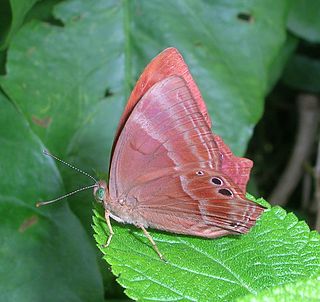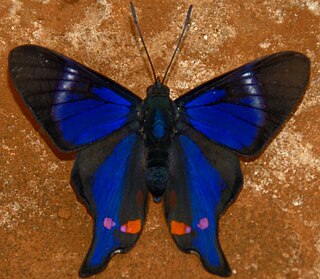
Riodinidae is the family of metalmark butterflies. The common name "metalmarks" refers to the small, metallic-looking spots commonly found on their wings. The 1532 species are placed in 146 genera. Although mostly Neotropical in distribution, the family is also represented both in the Nearctic, Palearctic, Australasian (Dicallaneura), Afrotropic, and Indomalayan realms.

Abisara savitri, the Malay tailed Judy, is a small butterfly found in Asia that belongs to the Punches and Judies, that is, the family Riodinidae.

The subfamily Theclinae is a group of butterflies, often referred to as hairstreaks, with some species instead known as elfins or by other names. The group is part of the family Lycaenidae, the "gossamer-winged butterflies". There are many tropical species as well as a number found in the Americas. Tropical hairstreaks often have iridescent blue coloration above, caused by reflected light from the structure of the wing scales rather than by pigment. Hairstreaks from North America are commonly brown above. Few Theclinae are migratory. Members of this group are described as 'thecline'.

Abisara is a genus of butterflies in the family Riodinidae, found in Africa and Southeast Asia.

The Mesosemiini are one of the tribes of metalmark butterflies. They are the basalmost living tribe of the Riodininae, outside the main radiation together with the slightly more advanced Eurybiini.

The Eurybiini are a small tribe of metalmark butterflies. They are one of the basal tribes of the Riodininae, outside the main radiation but not quite as primitive as the Mesosemiini. Though numerous Riodinidae genera have not yet been unequivocally placed in a tribe and the genus list is thus preliminary, it is not very likely that many other genera will end up being assigned here.

Zizeeria knysna, the dark grass blue or African grass blue, is a species of blue butterfly (Lycaenidae) found in Africa, on Cyprus and the Iberian Peninsula.

Rhetus periander, the Periander metalmark or variable beautymark, is a butterfly of the family Riodinidae. It is found in most of Central America and South America, ranging from Mexico to Brazil and Argentina.

Hesperocharis is a genus of butterflies in the family Pieridae. They are native to the Americas.

Lyropteryx apollonia, the Apollo metalmark, pink-dotted metalmark or blue-rayed metalmark, is a butterfly of the family Riodinidae, subfamily Riodininae, tribe Riodinini. The species was first described by John O. Westwood in 1851.

Abisara tantalus, the blue-spot Judy, is a butterfly in the family Riodinidae. It is found in Guinea, Liberia, Ivory Coast, Ghana, Nigeria, Cameroon, the Republic of the Congo, Angola and the Democratic Republic of the Congo. The habitat consists of humid and dense forests.
Abisara caeca is a butterfly and belongs to the Genus Abisara in the family Riodinidae. It is found in Cameroon, Gabon, the Republic of the Congo, Angola, the Democratic Republic of the Congo, Uganda and Tanzania. The habitat consists of swamp forests.
Abisara intermedia, the plain Judy, is a butterfly in the family Riodinidae. It is found in Ghana, southern Nigeria, Cameroon, Angola and the Democratic Republic of the Congo. The habitat consists of dense forests.

Abisara talantus, the blue Judy, is a butterfly in the family Riodinidae. It is found in Nigeria and Cameroon. The habitat consists of primary, dense forests.

Abisara rogersi, the light banded Judy, is a butterfly in the family Riodinidae. The species was first described by Herbert Druce in 1878. It is found in Nigeria, Cameroon, Angola, the Democratic Republic of the Congo, Uganda, Tanzania and Zambia. The habitat consists of shady areas in forests and open areas in submontane forests.
Saribia decaryi is a butterfly in the family Riodinidae. It is found on Madagascar. The habitat consists of forests.

Saribia perroti is a butterfly in the family Riodinidae. It is found on Madagascar. The habitat consists of forests.
Saribia ochracea is a butterfly in the family Riodinidae. It is found in eastern Madagascar. The habitat consists of lowland forests.
Helcystogramma helicopis is a moth in the family Gelechiidae. It was described by Edward Meyrick in 1922. It is found in Peru and Amazonas, Brazil.

Charis is a genus of the Riodinini tribe of metalmark butterflies. Nineteen species have been identified within the Charis cleonus complex and eight species within the Charis gynaea group (clade). Charis butterflies are common in the Neotropics and often live in primary and secondary growth. The Charis cleonus group exhibits contemporary parapatric distributions throughout Amazonia and are thought to have speciated allopatrically; residing in "areas of endemism". Some evidence suggests that Charis are reproductively isolated by mating preferences for different topographic areas and different times—of which, may have promoted speciation between the various groups.















